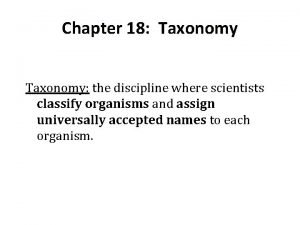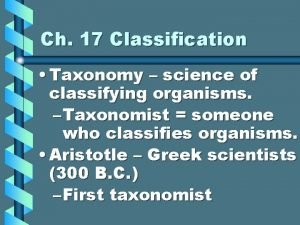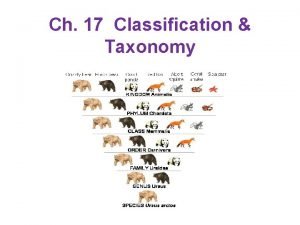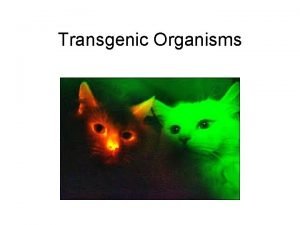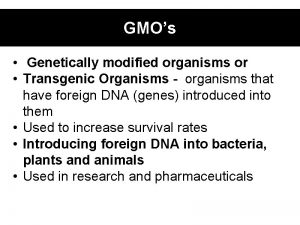CHAPTER 9 LESSON 2 Classifying Organisms ESSENTIAL QUESTIONS
















- Slides: 16

CHAPTER 9 LESSON 2 Classifying Organisms

ESSENTIAL QUESTIONS What methods are used to classify living things? Why does every species have a scientific name?

NEW VOCABULARY Binomial Nomenclature Species Genus Dichotomous Key Cladogram

CLASSIFYING LIVING THINGS Carolus Linnaeus was one of the first scientists to classify organisms (What does it mean to classify things? ) He classified them into 2 main groups called kingdoms Based on similar structures

DETERMINING DOMAINS Systematics: The current classification method for organisms Uses all known evidence to classify organisms Cell type How food and energy are obtained Structure and function of features Common ancestry Molecular analysis Organisms are now classified into one of 3 Kingdoms and then into one of 6 Kingdoms.

DOMAINS AND KINGDOMS

SCIENTIFIC NAMES Binomial Nomenclature: is a system for naming organisms with 2 word scientific name: Species name (group of organisms that have similar traits and are able to produce fertile offspring) Genus name (group of similar species) Example: Ursus arctos (Grizzly Bear) Ursus = Genus arctos = Species

SCIENTIFIC NAMES (CONTINUED) What domain does the Grizzly Bear belong to? What kingdom?

SCIENTIFIC NAMES (CONTINUED) Binomial nomenclature was developed by Linneaeus Scientific names are important because each species has its own scientific name These are the same worldwide Scientists don’t get confused about which species they are talking about

CLASSIFICATION TOOLS Dichotomous key: is a series of descriptions arranged in pairs that lead the user to the identification of an unknown organism. Cladogram: is a branched diagram that shows the relationship among the organisms, including common ancestors.

DICHOTOMOUS KEY

CLADOGRAM

QUESTION: Is my poster of life a dichotomous key or a cladogram?

REVIEW How many scientific names does each organism have? A. 1 B. 2 C. 3 D. Many

REVIEW Which of these refers to the system for naming organisms with two identifying scientific terms? A. Genus B. Cladogram C. Binomial Domains D. Binomial Nomenclature

REVIEW Which of these refers to a series of descriptions arranged in pairs that help identify an unknown organism? A. Dichotomous key B. Domain C. Cladogram D. Genus
 Classifying and exploring life
Classifying and exploring life Lesson outline classifying organisms
Lesson outline classifying organisms Lesson 2 classifying organisms answer key
Lesson 2 classifying organisms answer key Taxonomy of cat
Taxonomy of cat Classifying organisms worksheet
Classifying organisms worksheet In the discipline of taxonomy what is a domain
In the discipline of taxonomy what is a domain Discipline of classifying and naming organisms
Discipline of classifying and naming organisms Canis latrans classification
Canis latrans classification Why do scientists classify organisms?
Why do scientists classify organisms? What are the rules for writing scientific names
What are the rules for writing scientific names Discipline of classifying and naming organisms
Discipline of classifying and naming organisms Discipline of classifying and naming organisms
Discipline of classifying and naming organisms Member of the same species
Member of the same species Uni and multicellular organisms
Uni and multicellular organisms Plamatic acid
Plamatic acid Quadrilateral names
Quadrilateral names Classifying triangles lesson plan
Classifying triangles lesson plan








